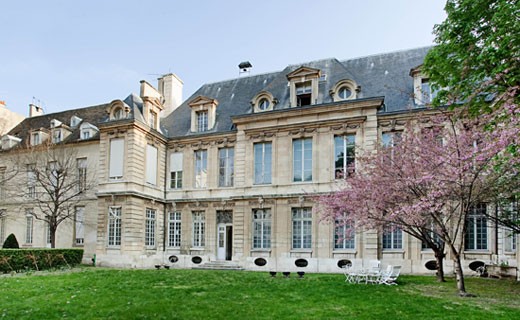Historic Hôtel Particulier de Miramion comes on the Market
Represented by Daniel Féau—Exclusive Affiliate for Christie's International Real Estate in Paris
After an extensive consultation, the public hospital system of Paris and its suburbs, or the “Assistance Publique des Hôpitaux de Paris” (AP-HP) chose Daniel Féau to exclusively manage the sale of the Hôtel de Miramion through a call for proposals. This magnificent private house, with 3 820 m² of usable floor space, is located at 47 quai de Tournelle in Paris’ Vth arrondissement. It currently houses the AP-HP Museum, as well as its administrative services. It will be free of occupation during the sale.
In the Days of the Bernardines
The land on which lies the Hôtel de Miramion was initially part of the “Clos de Chardonnet”—a stretch of land ranging from the Seine to the wooden plateau of Saint-Etienne du Mont, and bordered by the Bièvre. It is only after the Normand invasions that this zone developed itself and consequently transformed the landscape. Monastic settlements established themselves, and the arrival of new parishes marked the beginnings of urbanization. The first chapel Saint-Nicolas-du-Chardonnet was built around 1230 to accommodate the Seine’s boatmen. The Cisterian monk and Clairvaux abbot, Etienne de Lexington, was at the time convinced that the revival of the Church could only be achieved with the proper training. Consequently, the idea to create a Parisian establishment for the religious men of his abbey arose. This vast ensemble was built in 1247 and sheltered from the Philippe-Auguste mural. It comprised a college with an immense refectory on the ground floor, a parish church and monastic buildings. The high maintenance cost of the establishment led the monks to sell part of their plot in the late XVth century. Consequently, construction work multiplied itself on the land throughout the XVIth and XVIIth centuries. Influential families, for instance, saw opportunities to construct themselves private homes. As such, the Hôtel de Nesmond, the Hôtel de Selve (housing the 1st president of the Parlement de Paris), and the Hôtel de Christophe Martin emerged.
In the days of Christophe Martin
In the XVIIth century, the residents of the Quai de la Tournelle most often worked in finance, and particularly as managers of the King’s stables. They controlled the King’s market of cars, harnesses and horses in the Grand Stables. These activities represented a substantial source of enrichment. Christophe Martin, a cousin of the owners of the Hôtel de Selve and a renowned notable in the area, fully belonged to this social environment. In 1630, at the time state counselor, intendant and general manager of the King’s stables, Christophe Martin acquired a house built in the XVIth century. Upon the purchase he enlarged the house, and ultimately decided to transform into an aristocratic household. In order to expand his estate, he bought and rented shares of the Bernardine land, until he obtained close to 1 hectare. He transformed the quay’s dwelling, prolonged the XVIth century wing, and added two spans to prolong the Courtyard of Honor. At the back of the courtyard, he built a main dwelling, whose facade intertwiningly presents round dormers and cow’s eyes. On the garden-side, which is twice as big as the courtyard, this façade conveys a sense of monumentality. The order and the décor of the buildings demonstrate the quest for style and offer a true resemblance to the Hôtel d’Aumont, which was built around the same epoch. This household is in fact, like the latter, attributed to François Mansart.
In the days of Madame de Miramion
In 1675, a few years after the passing of Christophe Martin, Madame de Miramion acquired the Hôtel. She seconded Vincent de Paul in her devotion to charity programs. Nicknamed “mother of the Church” by Madame de Sévigné, and victim of a precocious widowhood, the pious Madame de Miramion decided to dedicate herself to God, the poor, and to girl’s education. In 1662, she founded the community of the Sainte Family, and later dedicated herself to the caring of the sick, and to the education of young poor girls. She eventually decided to merge the Sainte Family community to that of the Girls of Sainte Geneviève, which was founded 30 years earlier by Miss Blosset. She housed this new enlarged community in her recently-acquired hotel.
After the French Revolution
While initially spared by the secularization of Church property in 1789 – 1790, the community eventually got dissolved in 1794. The premises were gradually transformed into weaponry workshops, leaving some space for housing for the workers. In 1812, the General Council of Hospitals decided to transfer the Central Pharmacy of Hospitals, lodged since 1796 in the former “Hôpital des Enfants Trouvés” on the Ile de la Cité. For approximately 150 years, the Central Pharmacy occupied the Hôtel de Miramion.
A Protected Monument
In 1926, the Miramion hotel was registered on the French Supplementary Historic Monument list with the Order of February 22nd 1926. With the support of the Beaux-Arts Minister of the Daladier government, the “facades on the courtyard and on the garden, the painted beamed ceilings and the woodwork” received protection under the law for the preservation of Historic Monuments. The installation of the AP-HP Museum in 1934 was an important step for the promotion of this architectural ensemble.
Επικοινωνία
Daniel Féau Commercialisation 21, rue d’Artois, Paris 75008 Attention: Dorothée Legrand Phone: +33 (0) 1 56 88 48 48For more news from Christie’s International Real Estate, visit our Press Center »
.svg&option=N&w={0}&permitphotoenlargement=false&fallbackimageurl=https%3A%2F%2Fcire-staging.gabriels.net%2Fresources%2F_responsive%2Fimages%2Fcommon%2Fnophoto%2Fdefault.jpg)


